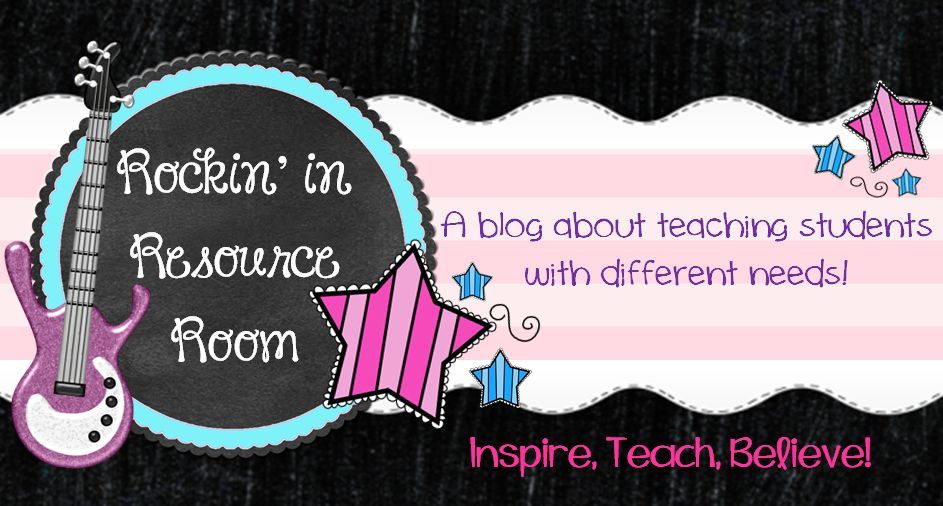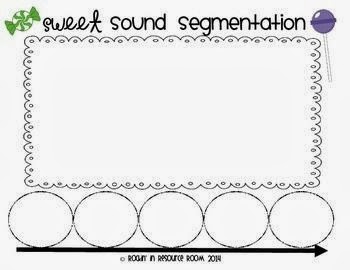1. Slinky Stretch
When we build words with our magnetic letters, we use slinkies to sound out our words. I give students the word, use it in a sentence, then my kiddos repeat it. Before they build the word with magnet letters, they grab their slinkies, and sound out the word by stretching the slinky. You can pick up a pack of 2 slinkies at Dollar Tree for $1, and they come in fun colors!
2. Word Walk
Young students need to get up and moving! This activity gets students using larger muscles to practice blending sounds together. I put construction paper with a letter on each piece on the floor. I pick out certain letters that we will be using. For example if we are doing the -un word family I will have the letters u, n, b, r, and s on the floor. I'll have the first word ready on the floor. The student(s) will walk the word, saying each sound as they walk. Then they tell me what the word is. When we move on to the next word, I tell them to change the first sound to another (Ex. "Change the /r/ to a /s/). Once they change it out, they walk it again, saying each sound as they step on it. Then they tell me what the word is. A variation of this activity is "Hula Hop". Lay hula hoops in a row and have students jump in one hula hoop for each sound.
3. Tap Lights
Another fun way to practice either blending or segmenting is tap lights! I also got these at Dollar Tree for $1 each. Students can use them to sound out the words by tapping each light and saying the sound. Then they say the whole word. They can also practice segmenting by listening to a word the teacher says, then tapping a light for each sound they hear. As they tap the light, they say the sound. I use it both ways. If you have a bunch of students and can't buy a lot of lights, you can have students sit in a row with a light in front of each of them. You can call out a word and then each student will tap their light and say a sound. For example, for the word "stamp", one student will tap a light and say /s/, the student sitting next to him/her will tap their light and say /s/, and so on. (Don't mind my student eating snack in the picture while doing this haha)
4. Blending Ball
In small groups, give students a word. The students will pass or roll the ball to one another, and say the next sound in the word as they catch it. For example, the teacher gives the word "dot". The teacher rolls or tosses a ball to the first student, who says /d/. That student passes it to the next one who says /o/, and so on. You can use any type of ball. I like to switch it up each week. We usually use a beach ball, ping pong balls, and tennis balls.
5. Texture Time
One fun way to practice blending sounds is to sound out words is with a textured surface. You can use foam, magnetic letters, etc. for the word. Then, students can slide their finger in some kind of texture in a tin, such as flour or shaving cream. As students sound out the word, they slide their finger in the texture saying each sound. In the picture, I used flour.
6. Blast Off!
My kiddos LOVE this fun way to practice blending and segmenting. To blend sounds together to decode a word, have students squat down. Next, they say the sounds in the word. Have the students jump up in the air and say the whole word. This can also be used to segment sounds. You would say the word out loud in a small group. Have a group of 3-4 students (depending on the words) and line them up in a row. Each student will squat down and say one sound. Once everyone says a sound in the word, they will all jump up at the same time and say the whole word. For example, if you have the word "big", one student will squat down and say /b/, the next would squat and say /i/, and the last student would squat and say /g/. Then everyone would jump up and shout "big!". (I apologize for no pics - we aren't allowed to post any pics of students).
7. Head, Shoulders, Knees, and Toes
This activity is another way to use your large muscle group to sound out or segment words. For blending sounds, the students will simply touch their head for the first sound, their shoulders for the second, their knees for the third, and their toes for the fourth sound. Have them start out slow, then they can blend the sounds faster and faster until the say the whole word. For segmenting, give students the word, and they will say each sound touching their heads, shoulders, knees, and toes.
8. Tap and Slide
This is similar to texture time, except your students can use a textured object to slide their finger under the word. Have students build the word by giving them the sounds. After the word is built, have them slide their finger underneath the word on a textured surface or object as they blend the sounds together. You can use felt, sandpaper, rope, carpet squares, etc. In this picture, I was using rope.
9. Bead Slide
Using a pipe cleaner and beads, have your students slide the beads along the pipe cleaner to sound out words. They can start out slow, then move them quicker. To segment sounds, give students a word and have them say each sound in the word as they slide a bead.
10. Elkonin Boxes
I love to use these with my students and create different ones to go with different holidays and times of the year. I call it "Sweet Sound Segmentation". I say a word, then the students slide a candy into each box to represent a sound. I use different types of candies with it. For Christmas, I used peppermint swirls, for Valentine's Day I used candy hearts, etc. Download a general template here for free! It also comes with directions and a recording sheet.
Hope you enjoy using these fun ways to practice blending and segmenting sounds. I would love to hear some of your ideas as well!
Ciao!
















Thank you for this post. I am looking forward to using these techniques with my 6 YO daughter. Thanks to Jolly Phonics she has a great grasp on letter sounds; however, it has been more difficult teaching blending sounds to form words. she learns best with music and movement.
ReplyDeleteYou're very welcome! Many of my students struggle with blending, so I'm always trying to use different things to keep them moving and hands-on. Let me know how it works for your daughter!
Delete